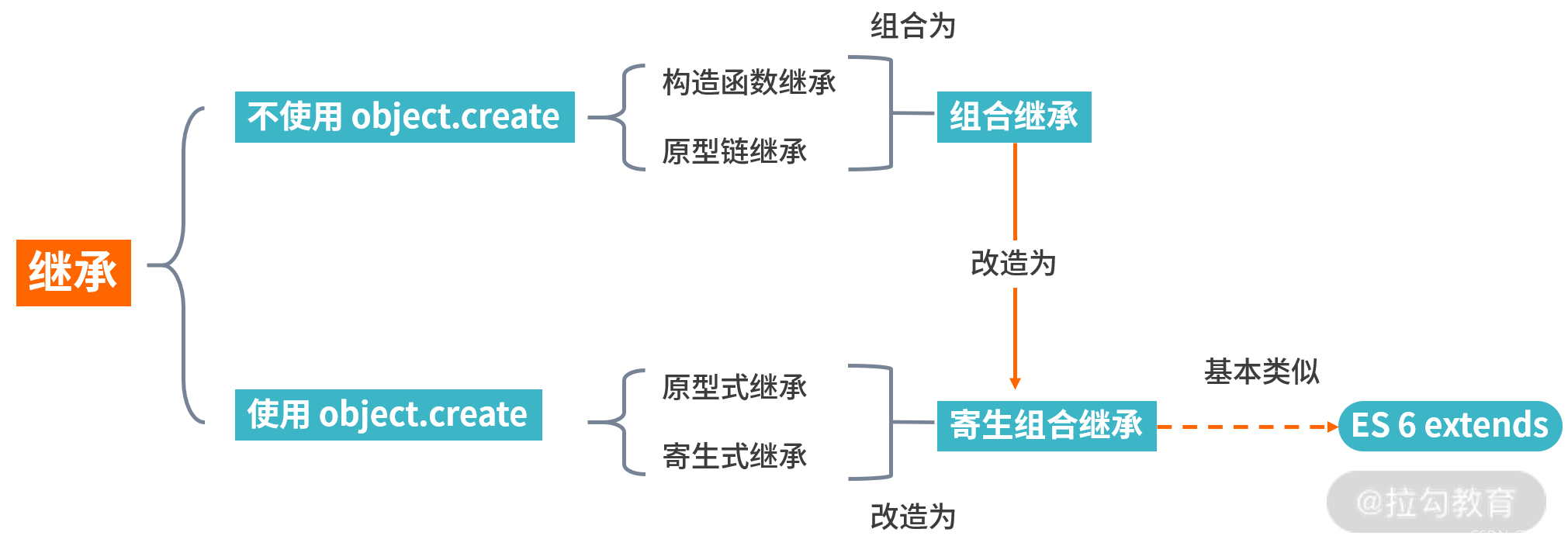1、原型链继承
核心: 将父类的实例作为子类的原型
function Parent1() {
this.name = 'parent1';
this.play = [1, 2, 3]
}
function Child1() {
this.type = 'child2';
}
Child1.prototype = new Parent1();
console.log(new Child1());
// 潜在的问题
let s1 = new Child1();
let s2 = new Child1();
s1.play.push(4);
console.log(s1.play, s2.play); // [1,2,3,4] [1,2,3,4]
// 两个实例使用的是同一个原型对象。
// 它们的内存空间是共享的,当一个发生变化的时候,另外一个也随之进行了变化特点:
1.非常纯粹的继承关系,实例是子类的实例,也是父类的实例
2.父类新增原型方法/原型属性,子类都能访问到
3.简单,易于实现
缺点:
1.要想为子类新增属性和方法,必须要在new Animal()这样的语句之后执行,不能放到构造器中
2.无法实现多继承
3.来自原型对象的所有属性被所有实例共享(来自原型对象的引用属性是所有实例共享的)
4.创建子类实例时,无法向父类构造函数传参
2、构造函数继承(借助 call)
核心:使用父类的构造函数来增强子类实例,等于是复制父类的实例属性给子类(没用到原型)
function Parent1(){
this.name = 'parent1';
}
Parent1.prototype.getName = function () {
return this.name;
}
function Child1(){
Parent1.call(this);
this.type = 'child1'
}
let child = new Child1();
console.log(child); // {name: 'parent1', type: 'child1'}
console.log(child.getName()); // error is not a function特点:
1.解决了原型链继承中,子类实例共享父类引用属性的问题
2.创建子类实例时,可以向父类传递参数
3.可以实现多继承(call多个父类对象)
缺点:
1.实例并不是父类的实例,只是子类的实例
2.只能继承父类的实例属性和方法,不能继承原型属性/方法
3.无法实现函数复用,每个子类都有父类实例函数的副本,影响性能
3、组合继承(前两种组合)
核心:通过调用父类构造,继承父类的属性并保留传参的优点,然后通过将父类实例作为子类原型,实现函数复用
function Parent3 () {
this.name = 'parent3';
this.play = [1, 2, 3];
}
Parent3.prototype.getName = function () {
return this.name;
}
function Child3() {
// 第二次调用 Parent3()
Parent3.call(this);
this.type = 'child3';
}
// 第一次调用 Parent3()
Child3.prototype = new Parent3();
// 手动挂上构造器,指向自己的构造函数
Child3.prototype.constructor = Child3;
var s3 = new Child3();
var s4 = new Child3();
s3.play.push(4);
console.log(s3.play, s4.play); // 不互相影响
console.log(s3.getName()); // 正常输出'parent3'
console.log(s4.getName()); // 正常输出'parent3'特点:
1.弥补了方式2的缺陷,可以继承实例属性/方法,也可以继承原型属性/方法
2.既是子类的实例,也是父类的实例
3.不存在引用属性共享问题
4.可传参
5.函数可复用
缺点:
调用了两次父类构造函数,生成了两份实例(子类实例将子类原型上的那份屏蔽了)
4、原型式继承
核心:ES5 里面的 Object.create 方法,这个方法接收两个参数:一是用作新对象原型的对象、二是为新对象定义额外属性的对象(可选参数)
let parent4 = {
name: "parent4",
friends: ["p1", "p2", "p3"],
getName: function() {
return this.name;
}
};
let person4 = Object.create(parent4);
person4.name = "tom";
person4.friends.push("jerry");
let person5 = Object.create(parent4);
person5.friends.push("lucy");
console.log(person4.name); // tom
console.log(person4.name === person4.getName()); // true
console.log(person5.name); // parent4
console.log(person4.friends); // ['p1', 'p2', 'p3', 'jerry', 'lucy']
console.log(person5.friends); // ['p1', 'p2', 'p3', 'jerry', 'lucy']通过 Object.create 这个方法可以实现普通对象的继承,不仅仅能继承属性,同样也可以继承 getName 的方法。
第一个结果“tom”,比较容易理解,person4 继承了 parent4 的 name 属性,但是在这个基础上又进行了自定义。
第二个是继承过来的 getName 方法检查自己的 name 是否和属性里面的值一样,答案是 true。
第三个结果“parent4”也比较容易理解,person5 继承了 parent4 的 name 属性,没有进行覆盖,因此输出父对象的属性。
最后两个输出结果是一样,其实 Object.create 方法是可以为一些对象实现浅拷贝的。
5、寄生式继承
使用原型式继承可以获得一份目标对象的浅拷贝,然后利用这个浅拷贝的能力再进行增强,添加一些方法,这样的继承方式就叫作寄生式继承。
虽然其优缺点和原型式继承一样,但是对于普通对象的继承方式来说,寄生式继承相比于原型式继承,还是在父类基础上添加了更多的方法。
let parent5 = {
name: "parent5",
friends: ["p1", "p2", "p3"],
getName: function() {
return this.name;
}
};
function clone(original) {
let clone = Object.create(original);
clone.getFriends = function() {
return this.friends
};
return clone;
}
let person5 = clone(parent5);
console.log(person5.getName()); // parent5
console.log(person5.getFriends()); // ['p1', 'p2', 'p3']通过上面这段代码,我们可以看到 person5 是通过寄生式继承生成的实例,它不仅仅有 getName 的方法,而且可以看到它最后也拥有了 getFriends 的方法。
6、寄生组合式继承
结合第四种中提及的继承方式,解决普通对象的继承问题的 Object.create 方法,我们在前面这几种继承方式的优缺点基础上进行改造,得出了寄生组合式的继承方式,这也是所有继承方式里面相对最优的继承方式。
function Parent6() {
this.name = 'parent6';
this.play = [1, 2, 3];
}
Parent6.prototype.getName = function () {
return this.name;
}
function Child6() {
Parent6.call(this);
this.friends = 'child5';
}
// 这里改用 Object.create 就可以减少组合继承中多进行一次构造的过程
child6.prototype = Object.create(parent6.prototype);
child6.prototype.constructor = child6;
Child6.prototype.getFriends = function () {
return this.friends;
}
let person6 = new Child6();
console.log(person6); // child6 {name: "parent6",play: [1, 2, 3], friends: "child5"}
console.log(person6.getName()); // parent6
console.log(person6.getFriends()); // child5通过这段代码可以看出来,这种寄生组合式继承方式,基本可以解决前几种继承方式的缺点,较好地实现了继承想要的结果,同时也减少了构造次数,减少了性能的开销.
总体看下来,这六种继承方式中,寄生组合式继承是这六种里面最优的继承方式
ES6 提供了继承的关键字 extends
class Person {
constructor(name) {
this.name = name
}
// 原型方法
// 即 Person.prototype.getName = function() { }
// 下面可以简写为 getName() {...}
getName = function () {
console.log('Person:', this.name)
}
}
class Gamer extends Person {
constructor(name, age) {
// 子类中存在构造函数,则需要在使用“this”之前首先调用 super()。
super(name)
this.age = age
}
}
const asuna = new Gamer('Asuna', 20)
asuna.getName() // 成功访问到父类的方法




















 1512
1512











 被折叠的 条评论
为什么被折叠?
被折叠的 条评论
为什么被折叠?








